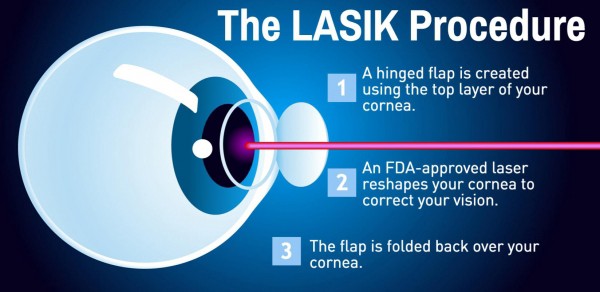What is
Lasik Surgery?
Commonly referred to as laser eye surgery or laser vision correction, is a type of refractive surgery for the correction
of myopia, hyperopia, and astigmatism. The LASIK surgery is performed by an ophthalmologist who uses a laser or microkeratome to reshape the eye's cornea in order to improve visual
acuity
What is the procedure of Lasik surgery?
First, your surgeon
uses a mechanical surgical tool called a microkeratome or a femtosecond laser
to create a thin, circular "flap" in the cornea
LASIK eye surgery: step by step
Then, the
surgeon folds the articulated flap to access the underlying cornea (called a
stroma) and removes part of the corneal tissue with an excimer laser.
This highly
specialized laser uses a beam of cold ultraviolet light to remove
("remove") microscopic amounts of tissue from the cornea to reshape
it in order to focus more precisely the light on the retina to improve vision.
For
short-sighted people, the goal is to flatten the cornea; With people with a
vision of the future, a more pronounced cornea is desired.
Excimer lasers
can also correct astigmatism by smoothing an irregular cornea in a more normal
way. It is a mistake to think that LASIK cannot treat astigmatism.
After the laser
removes the cornea, the flap is put back in place, covering the area where the
corneal tissue was removed. Then the cornea can heal naturally.
Laser eyesurgery only requires topical anesthetic drops and no bandages or stitches are
required.
Why Lasik Surgery?
- Improved vision
- Quick results
- Quick recovery
- Long lasting results
- No more contact lenses
- No more glasses
What
happens if you blink during laser eye surgery?
This is a common concern, but rest assured that blinking and
moving during LASIK surgery usually is not a problem. ... Also, a small device
will hold your eyelids open during the procedure so you can't accidentally
blink and your eyelids cannot interfere with any step of the surgery.
Is Lasik Surgery painful?
In most cases,
PRK and LASIK does not hurt during or immediately after the procedure. Before
your LASIK eye surgery begins, numbing eye drops are used to alleviate any pain
or discomfort to the eye during the procedure. LASIK does not hurt during the procedure;
however, you may feel some pressure on your eyes.
Can you watch TV after Lasik Surgery?
Continue to
avoid getting water in your eyes within the first 72 hours after a laser eyesurgery procedure. Reading, working on the computer and watching television can
be resumed 24 hours after LASIK surgery. If necessary, you may want to keep
your eyes lubricated during these activities.
How long do you have to wear sunglasses
after LASIK Surgery?
Wear sunglasses
to protect your eyes for at least the first week after LASIK surgery. Read in
moderation for the first few days after your LASIK procedure. Do not wear eye
makeup for one week. Do not rub your eyes for one month after you have LASIK.


Technical is Technical is an technology blog, focusing on technology trends. There are thousands of online technology magazines that give us news about the latest and greatest in this field and we've decided to create one of our own - a very niche magazine that focuses on Future Technologies and more.
ReplyDeleteonline magazine
Looking for straighten teeth and a perfect smile but don’t want metal braces, ceramic braces or lingual braces??? Don’t worry!!!! We can straight teeth without wires. Let your smile shine all life Long. Aligners is the best Innovation in Orthodontic Dentistry.
ReplyDeleteholy retainer
This comment has been removed by the author.
ReplyDeleteTRVLD’s online store offers fast shipping, bringing quality suitcases to your doorstep. Find your perfect suitcase today.
ReplyDeleteFind suitcases near me at TRVLD.